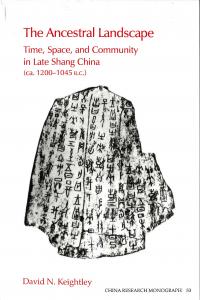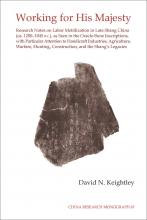The Ancestral Landscape
The Ancestral Landscape
David N. Keightley
This monograph presents insights of general historical and intellectual interest derived from the Shang oracle bone inscriptions from Anyang. These insights are integrated with an array of data from other fields of scholarship, including metereology, botany, zoology, astronomy, sociology, and archaeology. The result is a lively and multifaceted picture of Shang realities.
As a nonprofit academic press, we need your support to publish our books. Your gift can help us make more of our titles available as e-books. DONATE NOW
Title information
This monograph presents insights of general historical and intellectual interest derived from the Shang oracle bone inscriptions from Anyang. The insights are integrated with data from other fields, including metereology, botany, zoology, astronomy, sociology, and archaeology. By presenting a relatively large number of inscriptions, Keightley hopes to give readers an almost tactile sense, not only of what it was like to be a Late Shang king and a Late Shang diviner, but also of what it is to be a scholar who works with these materials. And by translating, in context, more than a hundred and fifty of the inscriptions, he also hopes to introduce readers to the ways in which the earliest written documents yet found in China may be studied.
David N. Keightley
David Keightley is professor emeritus of history at the University of California, Berkeley. His research has focused on early Chinese civilization and oracle bone script. His publications include Sources of Shang History: The Oracle-Bone Inscriptions of Bronze Age China, The Ancestral Landscape: Time, Space, and Community in Late Shang China (ca. 1200-1045 B.C.), and Working for His Majesty.
B.A., Columbia University; Ph.D., Columbia University
The Ancestral Landscape
Preface – vii
Citation and Transcription Conventions – xiii
1. Climate – 1
2. Agriculture – 9
Agricultural Schedule – 10
Pests and Diseases – 13
3. Time: Days, Nights, and Suns – 17
Day and Night – 19
Sun Cult – 25
The Shang Day – 29
4. Time: Calendrical Structures – 37
The Sixty-Day Cycle – 37
The Xun 旬 Week – 39
The Lunation – 43
The Five-Ritual Cycle – 47
The Numbered Si 祀 Ritual Cycle – 50
5. Space: Center and Periphery – 55
The Capital or Cult Center – 56
Tu 土: The Four Lands – 61
Fang 方 Areas and Powers – 66
Wu Powers – 72
Goings Out and Comings In – 74
6. Space: Cosmos and Orientation – 81
Orientation – 82
Cardinal Directions: The Land – 86
Cardinal Directions: The Weather – 91
Divination Bones as World Maps – 93
7. Community: The Land and Its Inhabitants – 97
The Royal Community – 98
Other Communities – 103
Men, Animals, and Landscape – 107
Powers on the Land – 113
8. Cosmologies and Legacies: The "Winds" of Shang – 121
Figures – 131
Tables – 143
Key to the Inscriptions Translated, by Reference Number – 147
Index to the Inscriptions Translated – 153
Bibliography A: Abbreviations for the Oracle-Bone Collections and Reference Works Cited – 159
Bibliography B: Other Works Cited – 163
Index – 201
|
BLURBS |
|
"This is a work of extraordinary maturity—a well-considered, incisive, careful, yet bold and highly original summation of insights gained over many decades of research….Keightley here presents in compelling and…understandable form some insights of general historical and intellectual interest that are derived from this rare body of original materials, and he integrates them with a dazzling array of data from other fields of scholarship—including metereology, botany, zoology, astronomy, sociology, and archaeology. The resulting lively and multifaceted picture of Shang realities is extremely impressive [...] The brilliant synthesis of the Shang social configuration of the cosmos that is presented here is unprecedented in its scope and startling in its clarity. It greatly exceeds all previous piecemeal work on the issue by Chinese, Japanese, and Western experts. Specialists as well as general readers will...feel deeply moved and inspired by this work...This is historical writings at its best." ~Lothar von Falkenhausen |
|
JOURNAL REVIEWS |
|
"Those who have a professional interest in Early China studies will find this book not only informative in its own right but also a good portal through which to enter more deeply into the material....But this is also a fine (and all too unusual) example of a scholarly book that is worth reading for pure pleasure, quite apart from its value as a source of particular information and analysis. Keightley's lucid prose and magisterial interpretive stance, together with the richness of the subject itself, make this book a rare treat. Even the footnotes are interesting. The Ancestral Landscape deserves to find a readership far beyond the confines of its scholarly field." ~John S. Major, in China Review International 9, no. 2 (Fall 2002): 460-464 (http://www.jstor.org/stable/23732132) |
|
“David Keightley is one of a handful of American scholars who have worked methodically to introduce the complexities of [oracle bone] scholarship to Western readers. Unlike many other scholars, his approach is to let the bones speak for themselves, and he only rarely introduces evidence from the later transmitted textual tradition. […] The Ancestral Landscape is an excellent tool for students to learn how historians can decipher the often-cryptic bone inscriptions for vital social, historical, and cultural information. ~Constance A. Cook, Lehigh University, in Journal of Chinese Religions 29, no. 1 (2001): 311–313 (http://dx.doi.org/10.1179/073776901804774686) |



